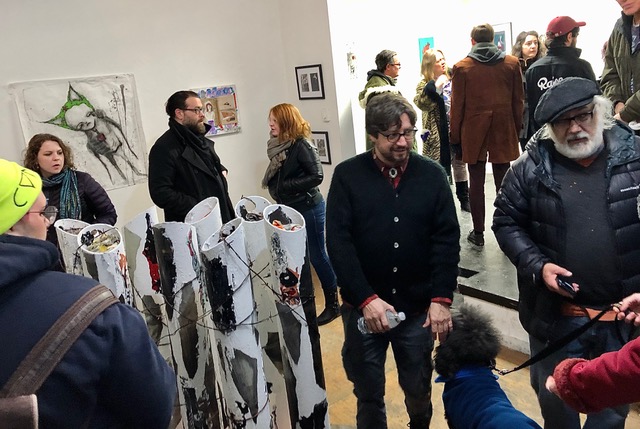A Valentine for a Lost Temple

Opening night at Doubting Thomas. Photo by Jim Szudy.
Artists need places to experiment, to try out new things and show them to the world and their friends and neighbors without having to worry about whether they will sell or not. Doubting Thomas Gallery in Tremont, owned by a pediatrician named Theresa Boyd, has been one of those rare communal art gathering spaces in Cleveland for the past two decades. That’s why it’s fitting that the gallery put on a remembrance show, curated by Shawn Mishak and with a Valentine’s Day opening, for the Temple of Lost Love–a makeshift art gallery under the Eagle Avenue bridge in the Flats that survived and was added to and subtracted from for 11 years (from 1991 to 2002) before it was absentmindedly painted over by city crews.
I wrote about the Temple in 2002, right after it disappeared, and was there that first night of performances and installations in 1991—just on the periphery. That night in 1991, I was struck by how artwork was one with the wrack and ruin of the city, glittering like a half-buried starscape in some Vesuvian pit. The steel-colored river sliced through the whole scene, stealthy, single-minded.

Patsy Kline and Tim Lachina. Photo by Jim Szudy.
It’s full circle for me to see artists come together for the Doubting Thomas show, those who built and “anti-worshipped” at the Temple and other, mostly younger artists who heard stories of the Temple and were inspired. Joan Deveney contributed an installation for the original event and for this show that both times brought into one orbit every random thing that was spinning on its own axis in the event. Jim Szudy’s footage of lost souls wandering the Temple grounds captures the underground spirit of the place. Cat Swartz’s vividly colored polymer/paper and clay wall sculptures are a resurrection riff on taxidermied animals. Looking supernatural, angry and powerful—they would have felt right at home guarding the underbelly of the bridge. Tim Joyce’s numerous collages in the show marry scribble, scrap and poetry in the best spirit of the Temple—they’re like William Blake’s Rust Belt lost years.
The show, which was only up for two weeks in February, caught the spark of the original open-air gallery: spur-of-the-moment, fun, devastating, beautiful, trashy. As they stepped inside, gallerygoers were greeted with a video featuring the late performance artist Frank Green, a brilliant writer with a distinctive giggle who had a gift for saying something incredibly personal and harsh just when you were starting to feel comfortable. In the video, Green, talks about how the Temple came to be: “I thought, why don’t we do something in a place that physically speaks of our history?” he said. “There really wasn’t that much of a plan. There were all kinds of professional organizations in town, but there really wasn’t anything that was alternative, that was counterculture.” It was an over-the-top gesture (with an overly sentimental name) that people clung to like their earliest romances, even after Green had moved on to other projects.
One of the great things about Cleveland is it’s still pretty gritty and spontaneous and real—another Temple could pop up under a bridge somewhere, and go unrecognized by most and be stumbled upon by a few who think they’ve stepped into, Alice in Wonderland style, some punk-rock apocalyptic dreamscape, and a Mad Hatter with a rusty stovepipe for a hat is serving them tea.
It’s an underrecognized piece of underground Cleveland history that should be remembered, for sure.


You must be logged in to post a comment.